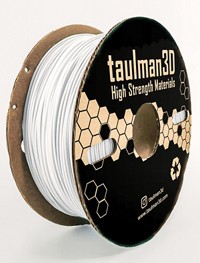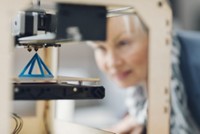Advertisement
Grab your lab coat. Let's get started
Welcome!
Welcome!
Create an account below to get 6 C&EN articles per month, receive newsletters and more - all free.
It seems this is your first time logging in online. Please enter the following information to continue.
As an ACS member you automatically get access to this site. All we need is few more details to create your reading experience.
Not you? Sign in with a different account.
Not you? Sign in with a different account.
ERROR 1
ERROR 1
ERROR 2
ERROR 2
ERROR 2
ERROR 2
ERROR 2
Password and Confirm password must match.
If you have an ACS member number, please enter it here so we can link this account to your membership. (optional)
ERROR 2
ACS values your privacy. By submitting your information, you are gaining access to C&EN and subscribing to our weekly newsletter. We use the information you provide to make your reading experience better, and we will never sell your data to third party members.
3-D Printing
Dutch masters—of 3-D printing
A new way of making things is taking hold in the flatlands of the Netherlands
by Alex Scott
June 4, 2018
| A version of this story appeared in
Volume 96, Issue 23

It is now possible to cycle across a 3-D-printed concrete bridge, see a canal house with a 3-D-printed facade, eat 3-D-printed food using 3-D-printed dentures, and source a host of 3-D-printed plastic or metal components—all in the Netherlands. The Dutch 3-D printing community is also working on electronics, lights, shoe insoles, concrete, metal, food, and pharmaceuticals.
The Dutch are embracing three-dimensional printing and the benefits it can bring—personalized production, reduced costs, and enhanced functionality—in a big way. The country’s early success in this field is due to a combination of government strategy and a culture that embraces innovation, some Dutch 3-D technologists say.
While the country’s 3-D printing sector is not about to dominate the industry globally, the Netherlands is punching above its weight, with a growing number of its firms now recognized worldwide. Sales from 3-D printing in the Netherlands doubled to about $120 million in 2016 compared with 2015, and further strong growth is anticipated, according to a 2017 report by the consulting firm Berenschot and the Dutch bank ABN AMRO.
“A dozen or so Dutch 3-D printing start-ups have emerged in recent years and made a name for themselves beyond the Dutch border,” says Terry Wohlers, president of Wohlers Associates, which has been analyzing the sector for three decades. Wohlers stresses that the Dutch 3-D printing industry is relatively small compared with the one in the U.S. Nevertheless, a cohort of players in the country stands out, he says.
For example, he points to Netherlands Organization for Applied Scientific Research (TNO), an independent Dutch research organization that has been working on 3-D printing technology for more than 20 years. Industry already deploys TNO technology to make—among other things—prototype products. TNO is now focused on developing intellectual property for printing pharmaceuticals, electronics, food, and industrial components.
The organization has a team of about 40 people developing 3-D printing equipment and a further 20 or so developing printing materials. All of its 3-D printing activities are housed within AMSystems Center, a collaboration with Eindhoven University of Technology (TU/e). The university contributes about 10 Ph.D. scientists to the partnership, including professors with expertise in materials chemistry.
One of AMSystems’ key projects is Hyb-Man, which features 10 Dutch and German firms and is developing 3-D printing methods for lighting and automotive production.
Among Hyb-Man’s partners are TU/e and the Dutch electronics giant Philips, both of which have played a role in catalyzing the growth of 3-D printing technology around the Eindhoven region of the Netherlands.
One of TU/e’s groundbreaking projects is its design and construction in the fall of 2017 of the world’s first 3-D-printed concrete bridge. TU/e printed the bridge using a giant robot that pumps out concrete in 1-cm layers. The researchers printed the layers to about 1 meter in height using a technique that can introduce voids in areas where less strength is required. Time and cost of production is less compared with traditional methods, the researchers say.
Also in Eindhoven, Additive Industries claims to have developed the world’s first metal 3-D printing system for series production. The firm’s technology results in a roughly 50% reduction in cost per part, CEO Daan Kersten says. Materials that the firm is printing include titanium, aluminum, stainless steel, and an aluminum-magnesium-scandium alloy. Applications include components for the aerospace and automotive sectors as well as medical implants.
Advertisement
But 3-D-printed materials in the Netherlands can also be edible. TNO, among others, is striving to lead in technology for making printed food. In particular, it is developing soft and hard gels that can be used to create customized textural sensations. “We can use gelling agents to make food for those with chewing and swallowing difficulties,” says Pieter Debrauwer, head of additive manufacturing equipment at TNO. “We can make pureed food appetizing and look like food again.”
Floris Hoff, formerly an intern with TNO, in 2014 created byFlow, which develops and sells 3-D printers for printing food. The firm has sold more than 150 printers, which feature refillable cartridges for different foods and effects.
They pack into a case weighing just 7 kg, making them perfect for catering on location, according to Milena Adamczewska, the firm’s marketing manager. Avocado, butter, and chocolate are easy to print, Adamczewska says. Jan Smink, a chef and adviser to the company, is about to open the first 3-D food restaurant, in the Dutch town of Wolvega.
While the food market is emerging, the 3-D printing of polymers is already thriving in the Netherlands. Multinational chemical companies have taken steps to access Dutch expertise in this area. In March, Mitsubishi Chemical acquired 3-D plastics technology start-up Dutch Filaments, which claims to be Europe’s largest producer of the plastic filaments that are melted to feed the 3-D printing process.
BASF has also pounced; last year it acquired Dutch polymer fibers technology start-up Innofil3D. BASF said the acquisition takes it further along the value chain so it can provide not just plastic granules for 3-D printing but also filaments.
Meanwhile, Dutch chemical major DSM also has ambitions to play a role in materials for 3-D printing. Rather than picking up a local technology partner, though, it recently acquired a minority stake in Chromatic 3D Materials, a start-up based in the U.S. While a local partner would have been easier to work with, Chromatic has the right technology, says Hugo da Silva, vice president of additive manufacturing for DSM.
Chromatic has know-how for making filaments out of polyurethane, which will enable DSM to accelerate its development of soft polymer products for 3-D printing, da Silva says. Among DSM’s projects are custom innersoles for shoes. In a bid to accelerate its growth in the field, DSM has several more tie-ups with companies in the pipeline, da Silva adds.
TNO’s Debrauwer attributes at least some of the growth in the Netherlands to Philips, which has a major 3-D printing effort at its labs in Eindhoven. Research at TU/e, Delft University of Technology, and the University of Twente, combined with efforts at a number of research institutes, further adds to the concentration of activity in the country, he says.
Debrauwer is optimistic that Dutch innovation in 3-D manufacturing will continue. He points to Eindhoven’s Brainport district, which is planning a large-scale sustainable living project that will try out innovative construction technologies, including ones based on 3-D printing.
But rather than being the result of government funding or research at universities or companies like Philips, the fast-growing cluster of Dutch 3-D printing firms may come down to the country’s willingness to try something new, byFlow’s Adamczewska says. “As we know, the Dutch are open minded when it comes to culture and a very tolerant nation. I think the same values are applicable to science.”




Join the conversation
Contact the reporter
Submit a Letter to the Editor for publication
Engage with us on Twitter